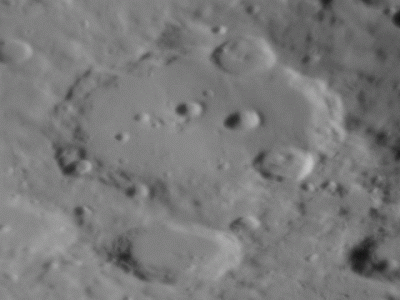Stacking in Astronomy
Stacking, as the name suggests, is the process of putting one picture on top of another. there might be varied motives behind why one would do this. In the context of astronomy and astro-photography, stacking is done in-order to reduce the noise in the picture and achieve the actual diffraction limited resolution images and to negate the effects of the atmosphere.
As is known, the earth's atmosphere is very turbulent and an unknown/un-noticed effect is that light bends when it passes through this turbulent atmosphere. while it might not be obvious naked eye, the effect of a turbulent atmosphere is quite obvious when you look at a planet or a star through a telescope.
Here you can see an example of the effect of of turbulence on pictures of the moon.
- source (i didnt ask for permission though).
As you can clearly see, these pictures are not consistent with each other.
You can read up this article on Astronomical Seeing to better understand the other effects of atmospheric turbulence while doing Astro-Photography.
Understand that Atmospheric turbulence is a random thing i.e the it's effects cannot be perfectly predicted (which might help us negate it from the pictures) but in most cases it's random.
And as you can understand by now, if we were to take multiple pictures of the same object, it will appear differently in each of these pictures.
Now if we were to 'stack' all of these pictures one on top of another and average them, you can assume that the overall noise in the image is reduced as the original source always remains constant but the effect of turbulence is random (from basic statistics). And viola, we have achieved the primary objective behind stacking.
While in real life, stacking isnt quite as simple as averaging over a number of pictures.
The reason for this can be because of in-efficient tracking (incorrect polar alignment , sidereal rate) or there might be other kinds of noise introduced into a picture due to the CCD used etc etc.
And there are quite a lot of methods to stack by as well.
One of the different methods used in stacking is Lucky Imaging is one of the different methods used to stack by. you can read up more about it here and here.
And there are quite a few (free) software outthere as well which can stack for you.
Some of the best ones are -
Deep Sky Stacker - as the name suggests, is to stack deep sky images.
Registax - for planetary and solar images. It's awesome :)
IRIS is one of the few advanced programs. havent used it myself. yet.
you can find a couple of other ones here.
While Fitswork is software doesnt stack for you, it is useful in Image Processing post stacking.
And aberrator is an interesting software to understand the effects of turbulence on a specific image.
PS - as you might or might not've noticed, the stars move in the night sky and taking pictures of the same planet or star isn't quite easy. which is why telescopes which are tracking enabled are used, using which, you guessed it, you can track the motion of the star and take pictures of the exact same patch of sky.
i suggest you contact your nearest amateur astronomer for more information.
